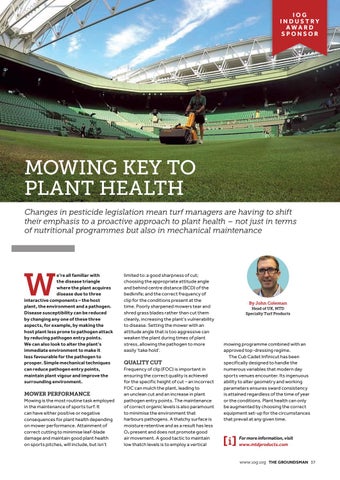IOG INDUSTRY AWARD SPONSOR
MOWING KEY TO PLANT HEALTH Changes in pesticide legislation mean turf managers are having to shift their emphasis to a proactive approach to plant health – not just in terms of nutritional programmes but also in mechanical maintenance
W
e’re all familiar with the disease triangle where the plant acquires disease due to three interactive components – the host plant, the environment and a pathogen. Disease susceptibility can be reduced by changing any one of these three aspects, for example, by making the host plant less prone to pathogen attack by reducing pathogen entry points. We can also look to alter the plant’s immediate environment to make it less favourable for the pathogen to prosper. Simple mechanical techniques can reduce pathogen entry points, maintain plant vigour and improve the surrounding environment.
MOWER PERFORMANCE
Mowing is the most routine task employed in the maintenance of sports turf. It can have either positive or negative consequences for plant health depending on mower performance. Attainment of correct cutting to minimise leaf-blade damage and maintain good plant health on sports pitches, will include, but isn’t
limited to: a good sharpness of cut; choosing the appropriate attitude angle and behind centre distance (BCD) of the bedknife; and the correct frequency of clip for the conditions present at the time. Poorly sharpened mowers tear and shred grass blades rather than cut them cleanly, increasing the plant’s vulnerability to disease. Setting the mower with an attitude angle that is too aggressive can weaken the plant during times of plant stress, allowing the pathogen to more easily ‘take hold’.
QUALITY CUT
Frequency of clip (FOC) is important in ensuring the correct quality is achieved for the specific height of cut – an incorrect FOC can mulch the plant, leading to an unclean cut and an increase in plant pathogen entry points. The maintenance of correct organic levels is also paramount to minimise the environment that harbours pathogens. A thatchy surface is moisture retentive and as a result has less O2 present and does not promote good air movement. A good tactic to maintain low thatch levels is to employ a vertical
By John Coleman Head of UK, MTD Specialty Turf Products
mowing programme combined with an approved top-dressing regime. The Cub Cadet Infinicut has been specifically designed to handle the numerous variables that modern day sports venues encounter. Its ingenuous ability to alter geometry and working parameters ensures sward consistency is attained regardless of the time of year or the conditions. Plant health can only be augmented by choosing the correct equipment set-up for the circumstances that prevail at any given time.
i
For more information, visit www.mtdproducts.com www.iog.org THE GROUNDSMAN 37
